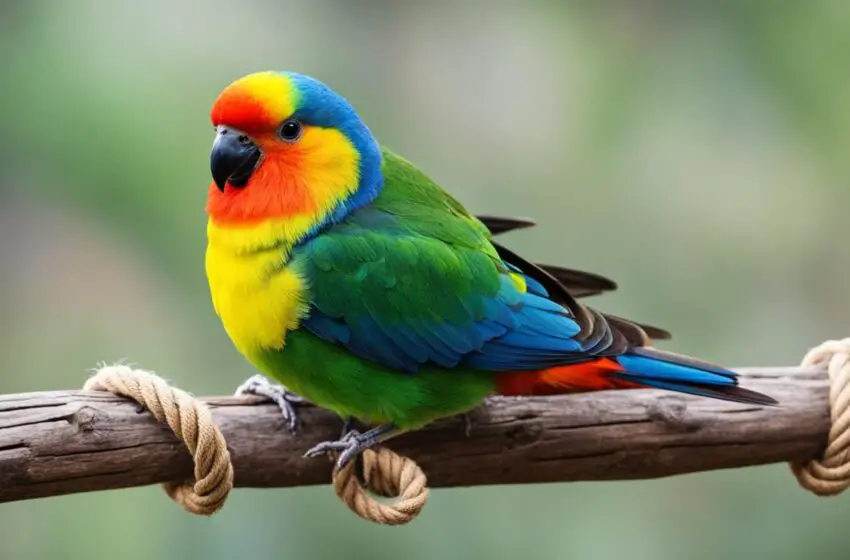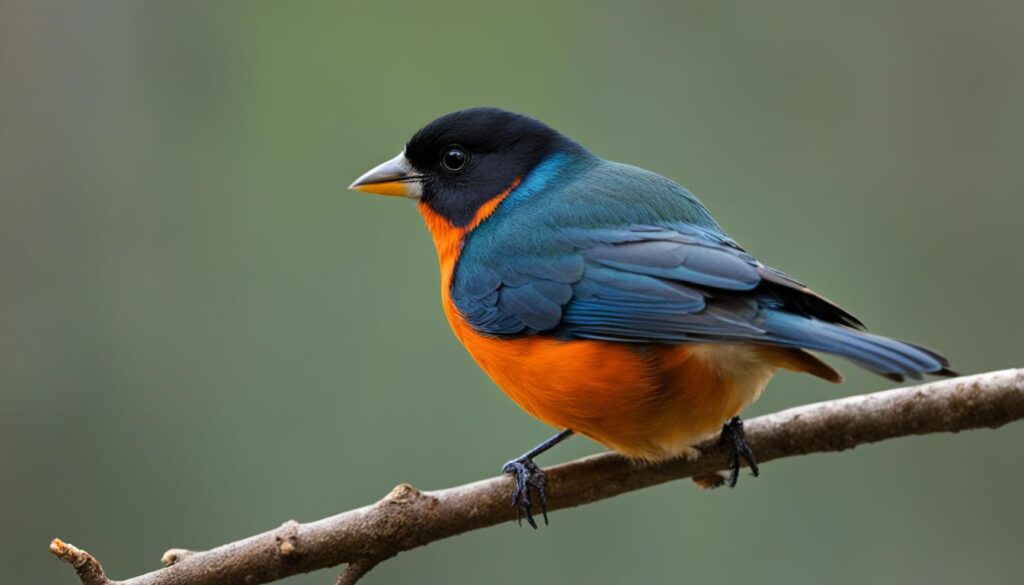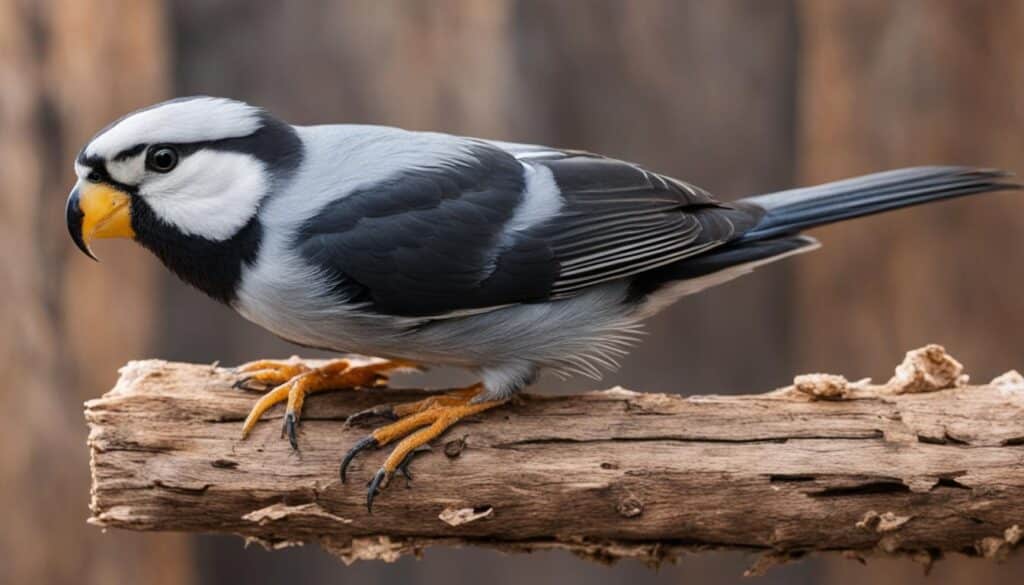Choosing the Right Perches for Your Pet Bird

When it comes to providing a comfortable and safe habitat for your pet bird, selecting the right perches is essential. Pet bird perches serve as a place for your bird to rest, exercise, and maintain its overall health. With a wide variety of options available, it’s important to make informed choices to ensure the well-being of your feathered friend.
Choosing the right perches for your pet bird involves considering factors such as the type of perches, their size, placement within the cage, texture, and material. By understanding the needs and preferences of your bird species, you can create a comfortable and stimulating environment that promotes their natural behavior and physical well-being.
Key Takeaways:
- Selecting appropriate perches is crucial for the comfort and safety of your pet bird.
- Consider the type of perches available, such as wooden, rope, and cement perches, to provide variety and meet your bird’s specific needs.
- Ensure the size and diameter of the perches are appropriate for your bird’s feet, preventing slipping or gripping too tightly.
- Strategically place perches in the cage, at different heights, away from food and water bowls, and near toys and interactive elements.
- Choose perches with suitable texture and made of safe and non-toxic materials, avoiding those with sandpaper covers.
Types of Bird Perches
When it comes to bird perches, there’s a wide range of options available to cater to your feathered friend’s needs. Let’s explore the different types of perches and their unique benefits:
1. Wooden Bird Perches
Wooden perches are a popular choice for their natural and comfortable surface. They resemble branches found in a bird’s natural habitat, providing a sense of security and familiarity. The varying diameters and textures of wooden perches help stimulate your bird’s feet and prevent foot problems. Plus, they add an aesthetic touch to your bird’s cage.
2. Rope Bird Perches
Rope perches offer flexibility and encourage your bird to exercise its feet and legs. These perches are made of soft, braided materials that promote healthy foot muscles and prevent foot sores. The textured surface of rope perches also aids in maintaining your bird’s grip strength. They are easy to install and can be twisted or bent into different shapes to add variety to your bird’s environment.
3. Cement Bird Perches
Cement perches serve a dual purpose: providing a textured surface for your bird to grip onto and trimming their nails. The rough texture of cement perches helps keep your bird’s nails naturally groomed, reducing the need for frequent nail trimming. However, it’s essential to monitor your bird’s comfort and prevent overgrowth of nails. Ensure that the cement surface is not the bird’s sole perch, as extended periods on rough perches can cause foot problems.
The variety of bird perches available allows you to create an engaging and comfortable environment for your pet bird. Whether it’s the natural feel of wooden perches, the flexibility of rope perches, or the dual benefits of cement perches, choose the perches that suit your bird’s needs and preferences.
Size and Diameter of Perches
When it comes to selecting perches for your pet bird, considering the appropriate size and diameter is essential for their comfort and safety. Birds spend a significant amount of time on perches, so it’s important to ensure that they can comfortably stand without slipping or gripping too tightly.
The perch should be wide enough for your bird to support its feet without causing strain or discomfort. A perch diameter of about 0.75 to 1 inch (1.9 to 2.5 cm) is generally suitable for small to medium-sized birds such as budgies, cockatiels, and lovebirds. Larger birds like parrots and macaws may require perches with a diameter between 1.25 to 2 inches (3.2 to 5 cm) to support their weight.
Having a variety of perch sizes in your bird’s cage allows them to have different foot positions, preventing foot problems caused by prolonged use of a single perch. It also helps simulate natural environments where birds encounter various perch sizes outdoors.
Here’s a helpful table summarizing the recommended perch sizes based on bird species:
| Bird Species | Perch Diameter |
|---|---|
| Budgies, cockatiels, lovebirds | 0.75 – 1 inch (1.9 – 2.5 cm) |
| Parrots, macaws | 1.25 – 2 inches (3.2 – 5 cm) |

Remember to consider your bird’s body size and weight when selecting perch sizes. If in doubt, consult with an avian veterinarian or bird expert for specific recommendations based on your bird’s species and individual needs.
By providing perches of appropriate sizes and diameters, you’ll create a comfortable and secure environment for your feathered friend to rest, play, and maintain their overall foot health.
Perch Placement in the Cage
Proper perch placement in your bird’s cage is essential for their overall well-being and comfort. By strategically arranging perches, you can create an environment that encourages exercise, mental stimulation, and a sense of security for your feathered friend.
Here are some key considerations for optimal perch placement:
Varying Heights and Locations
To provide variety and exercise opportunities, it’s important to arrange perches at different heights within the cage. This allows your bird to choose its preferred perching spot and encourages natural movement. Place perches at varying levels, such as high up near the cage ceiling, at mid-levels, and closer to the floor.
Consider creating a hierarchical arrangement, with the highest perch serving as a “commanding” spot for your bird and lower perches for rest or lower activity levels.
Avoiding Food and Water Contamination
When placing perches, make sure to avoid positioning them directly above food and water bowls. This prevents any droppings or debris from falling onto the food or contaminating the water, promoting a cleaner and healthier living space for your bird.
Enhancing the Cage Environment
Make the most of your bird’s cage space by placing perches near toys, interactive elements, or areas of interest. This stimulates your bird’s curiosity and encourages exploration and play. By integrating different elements, you can create an engaging and enriching environment that combats boredom and promotes mental and physical well-being.
“The right perch placement in the cage can make a significant difference in your bird’s overall satisfaction and quality of life.” – Avian Behavior Specialist, Jane Smith
Remember to regularly assess and adjust perch placement based on your bird’s preferences. Observe if your bird tends to favor certain perches or areas within the cage and make adjustments accordingly.
| Location | Suggested Perch Type |
|---|---|
| High-level perches near the cage ceiling | Sturdy wooden perches or platforms |
| Mid-level perches | Rope perches or natural branch perches |
| Lower perches | Flexible rope perches or natural branch perches |
By carefully considering perch placement in your bird’s cage, you can create an optimal layout that promotes their physical health, mental stimulation, and overall happiness.
Perch Texture and Material
When it comes to selecting perches for your pet bird, the texture and material are important factors to consider. The right texture and material can enhance your bird’s comfort and safety, promoting their overall well-being.
Natural wood perches with bark are an excellent choice as they provide a textured surface for your bird to grip. The rough texture mimics their natural environment, allowing them to maintain their balance and exercise their foot muscles. These perches not only offer a comfortable resting spot but also stimulate your bird’s natural instincts.
Avoid perches with sandpaper covers, as they can cause abrasions and foot problems. While they may seem like a good choice for trimming nails, the coarse texture of sandpaper can damage the sensitive skin on your bird’s feet. It’s best to prioritize their comfort and opt for alternative perch options.
When selecting the material for your bird’s perch, it’s crucial to choose safe and non-toxic materials. Birds often explore their surroundings with their beaks, and ingesting harmful materials can lead to serious health complications. Ensure that the perch is made from bird-safe materials free from any toxic substances. Examples of safe materials include untreated wood, stainless steel, and bird-safe plastics.
By choosing a perch with the right texture and material, you can provide a safe and comfortable environment for your feathered companion, promoting their physical and mental well-being.

Comparison of Perch Texture and Material
| Perch Type | Texture | Material |
|---|---|---|
| Natural Wood with Bark | Rough and textured | Untreated wood |
| Rope Perch | Soft and flexible | Cotton or hemp rope |
| Cement Perch | Textured and coarse | Cement or concrete |
| Plastic Perch | Smooth | Bird-safe plastics |
Regular Cleaning and Inspection
Keeping bird perches clean is essential for maintaining your bird’s health. Regularly remove and clean perches with mild soap and water to prevent the buildup of bacteria and dirt. Inspect perches for any signs of wear and tear, such as loose or splintered wood, and replace them as needed to ensure the safety of your bird.
By incorporating a regular cleaning and inspection routine, you can ensure that your bird’s perches remain in optimal condition and provide a safe environment for your feathered friend to perch and play.
Here’s a quick step-by-step guide on how to clean bird perches:
- Remove perches from the cage.
- Rinse off any loose debris with water.
- Fill a basin or sink with warm water and add a small amount of mild soap.
- Scrub the perches gently with a soft brush or sponge.
- Rinse thoroughly to remove any soap residue.
- Dry the perches completely before placing them back in the cage.
Remember to inspect the perches during the cleaning process. Look out for any signs of damage, such as cracks, splintered wood, or loose attachments. If you notice any issues, it’s important to replace the perch with a new one to prevent any potential harm to your bird.
| Benefits of Regular Cleaning and Inspection | Consequences of Neglecting Cleaning and Inspection |
|---|---|
|
|
Consider Your Bird’s Species and Behavior
Different bird species have unique preferences when it comes to perches. To create a comfortable and stimulating environment for your bird, it’s crucial to research their specific needs and behaviors. By tailoring perches to their natural behavior and physical characteristics, you can provide an ideal perch selection for your feathered friend.
For larger bird species, such as Macaws or Cockatoos, it’s important to choose sturdier and thicker perches that can support their weight and size. These birds often enjoy chewing and need perches that can withstand their powerful beaks. Opt for natural wood perches with a substantial diameter to accommodate their robust nature.
“Larger birds require sturdier and thicker perches to support their weight and size.”
On the other hand, smaller bird species, such as Finches or Canaries, have different needs. They prefer thinner and more flexible perches that allow them to exercise their delicate feet and minimize strain. Choose perches with a smaller diameter and materials that provide some give, such as rope or softer wood.
By understanding the unique characteristics of your bird’s species, you can provide appropriate perches that cater to their natural behavior and enhance their overall well-being.
Next, we will explore the importance of maintaining clean and inspecting perches regularly to ensure both safety and comfort for your feathered companion.
| Bird Species | Perch Type | Perch Diameter | Material |
|---|---|---|---|
| Macaws | Thick wooden perches | 1.5 inches | Hardwood |
| Cockatoos | Sturdy wooden or cement perches | 1-1.5 inches | Hardwood or concrete |
| Finches | Thin rope perches | 0.5-0.75 inches | Natural fibers |
| Canaries | Flexible wooden perches | 0.5-0.75 inches | Softwood |
Conclusion
Choosing safe and suitable perches for your pet bird is crucial for their comfort, health, and overall well-being. When selecting perches, it is important to consider factors such as the type, size, placement, texture, and material.
Firstly, consider the type of perch that best suits your bird’s needs. Wooden perches provide a natural and comfortable surface for your bird to stand on, while rope perches offer flexibility and help exercise their feet and legs. Cement perches can also be beneficial for nail trimming and grip.
Secondly, ensure that the size and diameter of the perches are appropriate for your bird. The perch should be wide enough for them to comfortably stand on without slipping or gripping too tightly. Having a variety of perch sizes in the cage allows for different foot positions and helps prevent foot problems.
Furthermore, proper perch placement within the cage is essential for your bird’s well-being. Arrange perches at various heights to provide variety and encourage exercise. Avoid placing perches directly above food and water bowls to prevent contamination. Consider placing perches near toys and interactive elements to enhance your bird’s environment.
Additionally, the texture and material of the perch are important factors to consider. Opt for natural wood perches with bark, as they provide a textured surface for grip and mimic the bird’s natural habitat. Avoid perches with sandpaper covers, as they can cause foot problems. Choose perches made of safe and non-toxic materials.
Lastly, regular cleaning and inspection of perches are vital to maintain your bird’s health. Clean perches with mild soap and water to prevent the buildup of bacteria and dirt. Inspect perches for any signs of wear and tear, such as loose or splintered wood, and replace them as needed to ensure your bird’s safety.
By considering these factors and selecting the proper perches, you can provide a safe and comfortable habitat for your pet bird, ensuring their happiness, health, and security in their living space.
FAQ
Why is choosing the right perch important for my pet bird?
Choosing the right perch is important for your pet bird because it provides a comfortable and safe habitat for them to rest, exercise, and maintain overall health.
What are the different types of bird perches available?
The different types of bird perches available include wooden perches, rope perches, and cement perches.
How do I determine the size and diameter of perches for my bird?
The size and diameter of perches should be wide enough for your bird to comfortably stand on without slipping or gripping too tightly. It is recommended to have a variety of perch sizes in the cage to allow for different foot positions and prevent foot problems.
What is the optimal placement of perches in the bird’s cage?
Perches should be arranged at different heights to provide variety and encourage exercise. It’s important to avoid placing perches directly above food and water bowls to prevent contamination. Additionally, consider placing perches near toys and interactive elements to enhance your bird’s environment.
What texture and material should the perch have?
The perch should have a natural wood texture with bark to provide a textured surface for grip and mimic the bird’s natural environment. Avoid perches with sandpaper covers, as they can cause abrasions and foot problems. Opt for perches made of safe and non-toxic materials.
How do I clean and inspect bird perches?
Regularly remove and clean perches with mild soap and water to prevent the buildup of bacteria and dirt. Inspect perches for any signs of wear and tear, such as loose or splintered wood, and replace them as needed to ensure the safety of your bird.
Should I consider my bird’s species and behavior when selecting perches?
Yes, different bird species have different perch preferences. Research the specific needs and preferences of your bird’s species to select perches that accommodate their natural behavior and physical characteristics.
Why is choosing the right perch important for my pet bird?
Choosing the right perches for your pet bird is essential for their comfort, health, and well-being. It ensures they have a suitable and safe habitat in their living space.



